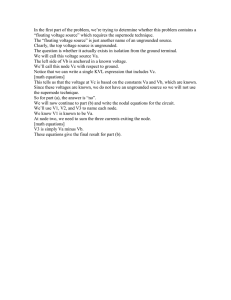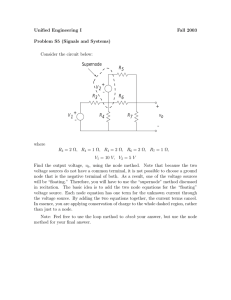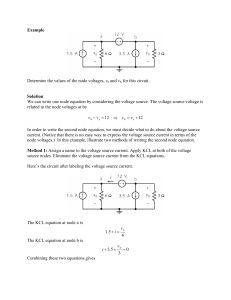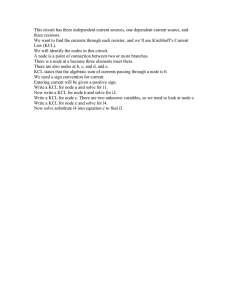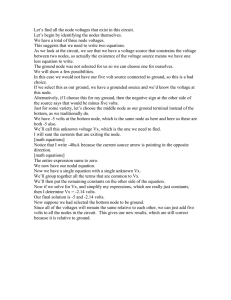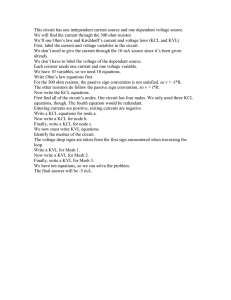Lecture 5
advertisement
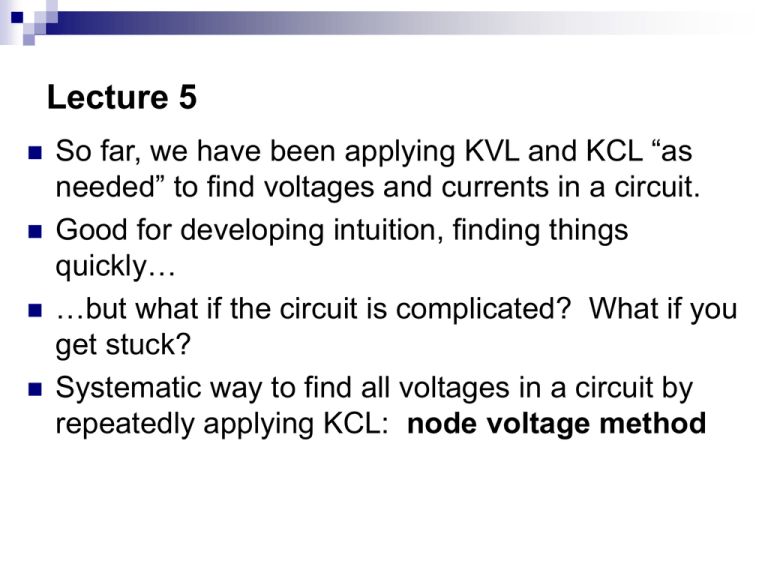
Lecture 5 So far, we have been applying KVL and KCL “as needed” to find voltages and currents in a circuit. Good for developing intuition, finding things quickly… …but what if the circuit is complicated? What if you get stuck? Systematic way to find all voltages in a circuit by repeatedly applying KCL: node voltage method Branches and Nodes Branch: elements connected end-to-end, nothing coming off in between (in series) Node: place where elements are joined—includes entire wire Node Voltages The voltage drop from node X to a reference node (ground) is called the node voltage Vx. Example: a + Va _ b + + _ Vb _ ground Nodal Analysis Method 1. Choose a reference node (aka ground, node 0) (look for the one with the most connections, or at the bottom of the circuit diagram) 2. Define unknown node voltages (those not connected to ground by voltage sources). 3. Write KCL equation at each unknown node. How? Each current involved in the KCL equation will either come from a current source (giving you the current value) or through a device like a resistor. If the current comes through a device, relate the current to the node voltages using I-V relationship (like Ohm’s law). 4. Solve the set of equations (N linear KCL equations for N unknown node voltages). * with “floating voltages” we will use a modified Step 3 Example node voltage set R1 + - V1 Va R 3 R2 What if we used different ref node? Vb R4 IS reference node Choose a reference node. Define the node voltages (except reference node and the one set by the voltage source). Apply KCL at the nodes with unknown voltage. Va V1 Va Va Vb 0 R1 R2 R3 Vb Va Vb IS R3 R4 Solve for Va and Vb in terms of circuit parameters. Example R1 Va R3 V 1 R2 I1 R4 R5 V2 Va V1 Va Va V2 I1 R1 R4 R5 “Floating” Voltage Sources A “floating” voltage source is a voltage source for which neither side is connected to the reference node. Vfloat in the circuit below is an example. V Vfloat Vb a - + I1 R2 R4 I2 Problem: We cannot write KCL at node a or b because there is no way to express the current through the voltage source in terms of node voltages. Solution: Define a “supernode” – a surface around the floating voltage source. Express KCL at this supernode. Example supernode Va Vfloat - + I1 Vb R2 R4 I2 Va Vb Two unknowns: Va and Vb. I1 I2 Get one equation from KCL at supernode: R 2 R 4 Get a second equation from the property of the voltage source: Vfloat Vb Va Example R1 Va V2 Vb |+ V1 + R2 R3 R4 Can we choose ground to avoid a floating voltage source? Not in this circuit. Va V1 Va Vb 0 R1 R2 R 4 Vb Va V2 Notes When there is a floating voltage source, that source knocks out two KCL equations (it messes up KCL for both of the nodes to which it is attached) Those two equations are recovered as follows: Get one equation via KCL on supernode surface. The floating source itself tells you the difference in voltage between its two endpoints. This difference is the second equation. Nodal analysis always leaves us with a complete set of linearly independent equations, unless there are violations of KVL or KCL or “impossible devices” in the circuit. The proof of this uses graph theory, and we will look into it later in the semester. Circuit analysis software uses nodal analysis.

